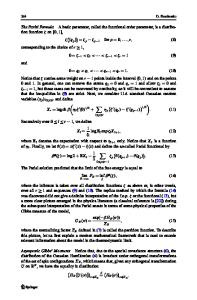On the bending strength of single-crystal silicon theta-like specimens Rebecca Kirkpatrick
- PDF / 323,394 Bytes
- 5 Pages / 612 x 792 pts (letter) Page_size
- 69 Downloads / 252 Views
esearch Letters
On the bending strength of single-crystal silicon theta-like specimens Rebecca Kirkpatrick, William A. Osborn, Michael S. Gaither, Richard S. Gates, Frank W. DelRio, and Robert F. Cook, Materials Measurement Science Division, Material Measurement Laboratory, National Institute of Standards and Technology, Gaithersburg, Maryland 20899 Address all correspondence to Robert F. Cook at [email protected] (Received 2 April 2013; accepted 15 May 2013)
Abstract A new theta geometry was developed for microscale bending strength measurements. This new “gap” theta specimen was a modification of the arch theta specimen that enabled microscale tensile testing. The gap theta specimen was demonstrated here on single-crystal silicon, microfabricated using two different etch processes. The resulting sample strengths were described by three-parameter Weibull distributions derived from parameters determined using established arch theta strengths, assuming a specimen-geometry and -size invariant flaw distribution and an approximate loading configuration.
In a recent Letter,[1] a new geometry of test specimen was introduced that enables microscale tensile testing. The specimen, in the form of the Greek letter Θ, consists of a frame with a circular exterior, an interior profile based on two circular arches and a web across the center, and a hat structure at the top, all of which are attached to a macroscale strip at the base. A uniaxial tensile stress state is generated in the web region when the circular exterior is diametrally compressed, enabling tensile fracture strengths to be measured. The circular arches in the frame interior of the new specimen simplified the complex internal geometry of the original theta design[2] and the top hat structure minimized loading misalignments and stress concentrations at the loading point.[3] The arch theta specimen design was an extension of an earlier microscale Durelli theta tensile strength specimen,[4] and has subsequently been used in detailed studies of the effects of microfabrication method and surface finish on tensile strength distributions of single-crystal silicon.[5,6] In this Communication, a further variation of the theta specimen is introduced that enables microscale bending strength measurements—the “gap theta”. In the arch design the web section is continuous whereas in the gap design the web section is disjointed, resulting in a bending stress state along the frame periphery and no stress in the web under the same diametral loading scheme. Both arch and gap theta test specimens can be microfabricated simultaneously, enabling direct comparison of tensile and bending strengths of lithographically closely related specimens with the same surface finish, but with significantly different stressing modes and stressed areas. A major motivation for the development of the microscale theta specimen is to enable microelectromechanical systems (MEMS) developers and manufacturers to optimize MEMS component reliability[6] using theta specimen measurements to guide design, fabrication
Data Loading...







